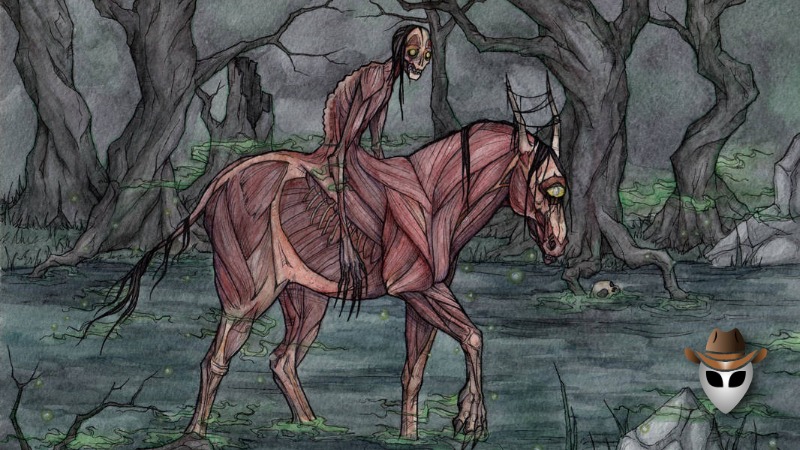In the rich folklore of my ancestral homeland of Scotland, few creatures capture the imagination quite like the Nuckelavee. With its horrific appearance and malevolent nature, the Nuckelavee stands out as a particularly chilling figure.
The Nuckelavee is a creature of the Orcadian tradition, native to the Orkney Islands of Scotland. Described as a nightmarish amalgamation of horse and man, it is said to be a colossal, skinless figure with a horse’s head and a human’s torso. Its exposed muscles and veins glisten with a sickly, otherworldly sheen. The Nuckelavee’s breath is said to blight crops and plague livestock, and its presence is often associated with disease and decay.
According to folklore, the Nuckelavee is an embodiment of chaos and destruction, a remnant of an ancient and malevolent spirit. Its origins are often linked to the mythic world of the Trows, malevolent beings akin to trolls in Norse mythology. The Nuckelavee’s most infamous tale involves its rampage across the Orkney Islands, wreaking havoc on villages and farms before it was supposedly driven away by a brave hero or, in some versions, a divine intervention.
Evidence Supporting the Existence of the Nuckelavee
Historical Accounts and Folklore
The primary evidence for the Nuckelavee’s existence comes from historical accounts and local folklore. Ancient texts and oral traditions from the Orkney Islands frequently mention this creature. Historical records from the 17th and 18th centuries, including those by folklorists and chroniclers, describe encounters with the Nuckelavee, suggesting that belief in the creature was widespread and deeply rooted in Orcadian culture.
Cultural Significance
The Nuckelavee’s role in Orcadian folklore is more than mere superstition; it reflects the cultural and environmental anxieties of the time. Stories of the Nuckelavee served as cautionary tales about the dangers of the natural world and the perils of neglecting traditional practices. The creature’s association with disease and disaster underscores the importance of adhering to customs believed to ward off malevolent forces.
Unexplained Phenomena
Some proponents of the Nuckelavee’s existence point to historical reports of unexplained phenomena, such as unusual animal deaths and crop failures, as potential evidence of the creature’s presence. While these events could be attributed to natural causes, their timing, and frequency often coincided with sightings of the Nuckelavee, lending an air of mystery to the folklore.
Arguments Against the Nuckelavee’s Existence
Rational Explanations
Many skeptics argue that the Nuckelavee is purely a product of folklore and superstition. They suggest that the creature’s terrifying attributes are symbolic representations of real-world fears and anxieties rather than an actual entity. The descriptions of the Nuckelavee’s horrific appearance and destructive nature can be seen as allegorical, reflecting the harsh realities of life in the Orkney Islands rather than a literal monster.
Lack of Physical Evidence
Despite numerous accounts and stories, there is no tangible physical evidence to support the Nuckelavee’s existence. No fossil records, artifacts, or remains have been discovered that could corroborate the creature’s presence. The Nuckelavee remains a purely mythical entity with no empirical evidence to substantiate its existence.
Psychological and Social Factors
The Nuckelavee’s fearsome characteristics can be attributed to psychological and social factors. Folklore often serves to explain and rationalize the unknown or the uncontrollable aspects of life. The Nuckelavee could be a manifestation of collective fears or social anxieties, used to reinforce moral or cultural norms within the community. The creature’s stories may have been exaggerated or embellished over time, contributing to its mythological status.
The Nuckelavee in Perspective
The Nuckelavee stands as a powerful symbol of the interplay between myth and reality. While the creature’s existence remains unproven, its role in folklore and cultural history is undeniable. The stories of the Nuckelavee offer insight into the fears and values of the Orkney Islanders, highlighting how myth can reflect and shape cultural identity.
Ultimately, whether the Nuckelavee is viewed as a genuine menace or a mythological construct, it serves as a reminder of the rich and complex nature of human storytelling. As we explore these ancient Scottish tales, we gain a deeper appreciation for the ways in which folklore bridges the gap between the known and the unknown, blending history, culture, and imagination into a captivating narrative.
What do you think? Is the Nuckelavee a real creature? Have you had your own experiences with the Nuckelavee? Share your story in the comments below!
